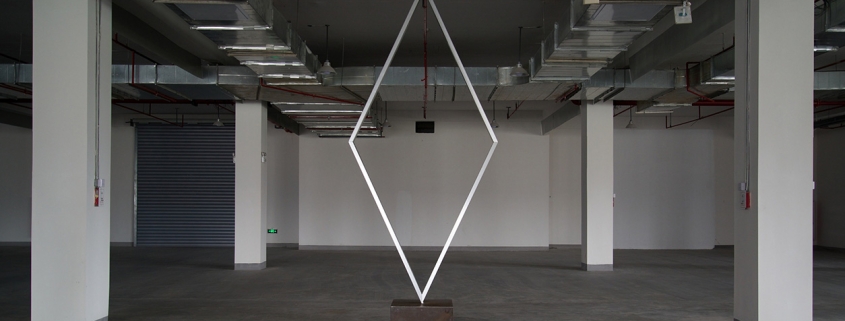HOMBRE MASA
Lolo & Sosaku
Curator: Laura Tammen
STATEMENT
Produced in Iasi by Barcelona based artists Lolo y Sosaku, Hombre Masa is an exhibition in two parts. Taking place simultaneously in the Palace of Culture and Borderline Art Space, the show aims to connect the spaces by reflecting on their social scope, inherent connotations, or adapted expectations, as well as its possibilities.
“Dancer (Palace)”, a large-scale parallelogram shaped kinetic sculpture, contracts and unfolds in steady intervals in a continuous interplay of force and counterforce, action and reaction. Harmonising with the neo-gothic architecture of the Palace of Culture, it classifies itself within the building’s history and conforms to its expectations of its representative space. The work expresses inspiration in movement, interpreting dance as a ritual, a custom and a form of social interaction, but due to its dimensions and rigidity in movement, it appears cold and distant, isolating itself within its inscribed circle.
As an antithesis to this, the sound-piece “Hombre Masa” pervades the entire exhibition at Borderline Art Space. An ensemble of sound recordings carried out during the construction of the sculpture and merged with recordings made in public spaces, “Hombre Masa” reflects on its social components, especially on the collaborative creation process with local welders.
Centrepiece of the exhibition at Borderline Art Space is a large rotating asymmetrical cross, without any religious implications. Continuosly moving, the horizontal bar hits the gallery walls and provokes friction between the metal material and the limits of the space, all the while producing sounds and leaving erosive scratches on the walls. The cross serves as a kind of revolving door through which the spectator, after observation and acceptance, is able to enter the gallery and find some space after having overcome these obstacles.
As a rotating X mark – an indicator or common concept of negation – the cross states our presence in time and space. Seemingly at odds with its environment, the work imposes on the space not only with its obstructive nature and ambitious size, but also with the physical corrosion evoked on the walls. These elements are again part of the two iron plates, “Esquema I” and “Esquema II”, exhibited at the entrance of the gallery and are graphic interpretations of the sculpture’s movement, its form and friction. On their plain surface, they display deep marks produced with the same tools used to create the sculptural intervention.
The works exhibited at Borderline Art Space and the Palace of Culture unite as a monument to conjoint sacrifice and labour, a necessary conscious presence within history and evolution as outcome of social values like cooperation and collaboration which go beyond conformity and complacency – similar to Ortega y Gasset’s concept of the „hombre masa“. The „hombre masa“ (mass man) is described in his essay „Revolt of the Masses“ (1930) in which he examines the political and social crisis of Europe and of Western civilization in general, extremely relevant in this time of hyper-democracy. The hombre masa is a warning against the conformity of the masses and their tendency to negate individual creativity and freedom, an intensifier of crushing mass movements of ideologies that have dominated Europe and the world for a considerable time – and is still relevant today.

